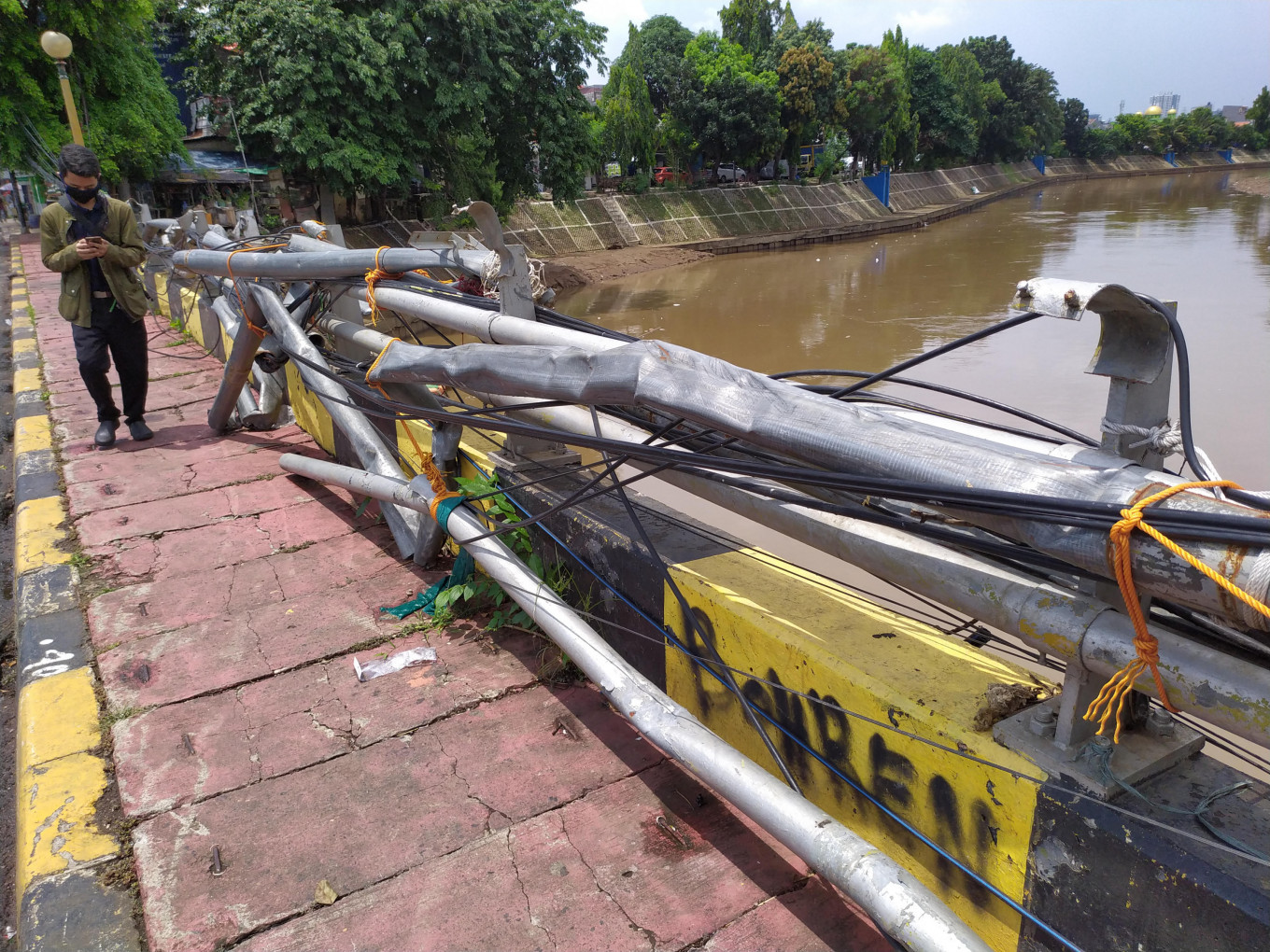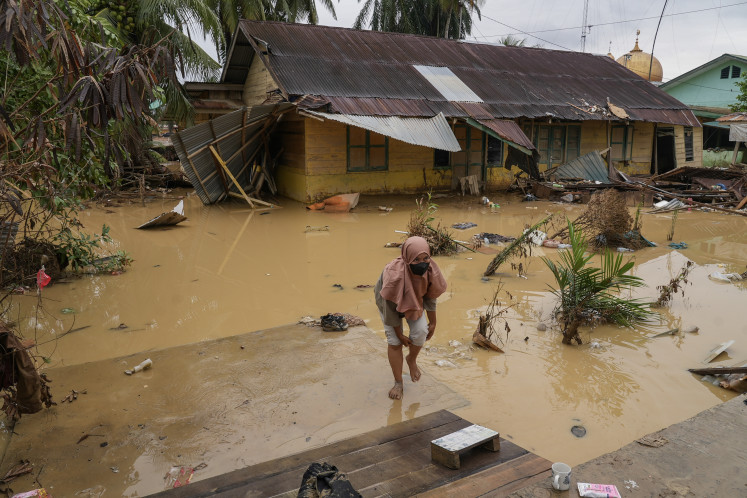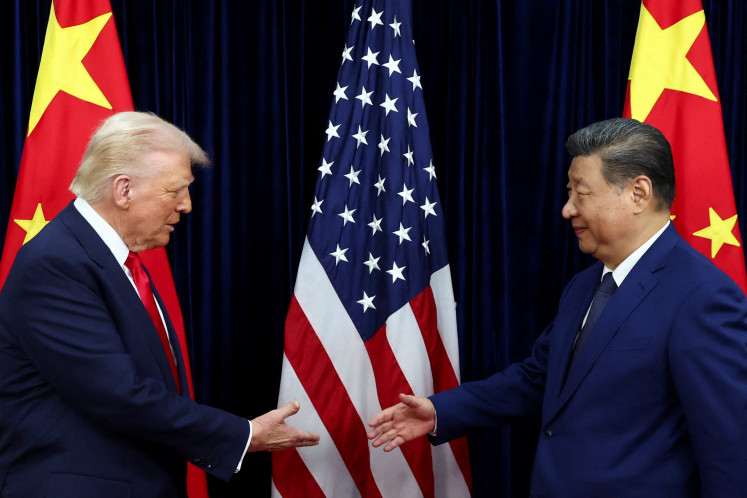Popular Reads
Top Results
Can't find what you're looking for?
View all search resultsPopular Reads
Top Results
Can't find what you're looking for?
View all search resultsHow COVID-19 will dampen Indonesia’s infrastructure developments
Finding a budget to fill the gap will get harder as Indonesia’s economy and finances come under pressure from the COVID-19 pandemic. This will in turn affect infrastructure development.
Change text size
Gift Premium Articles
to Anyone
 A man passes near the iron pillar of the Kali Ciliwung bridge, Kampung Melayu, East Jakarta on Wednesday, April 8, 2020 which was damaged. The bridge's iron poles were damaged by being hit by heavy equipment when lifting large-sized garbage from Ciliwung River during a big flood several months ago. (JP/P.J.Leo)
A man passes near the iron pillar of the Kali Ciliwung bridge, Kampung Melayu, East Jakarta on Wednesday, April 8, 2020 which was damaged. The bridge's iron poles were damaged by being hit by heavy equipment when lifting large-sized garbage from Ciliwung River during a big flood several months ago. (JP/P.J.Leo)
T
he Indonesian economy is plagued by a range of “infrastructure gaps”, places where much-needed physical and digital infrastructure is either substandard or absent, mostly due to under-investment.
For example, many hospitals and clinics in remote provinces lack 24-hour access to clean water and electricity. Due to Indonesia’s rapid growth, industrialization and urbanization in the past 20 years, its infrastructure needs have soared.
Successive Indonesian governments at all levels have struggled to build infrastructure at the pace required. The result has constrained its domestic economic performance and its trade integration with the broader Indo-Pacific region.
Estimating the investment required to close these gaps is challenging. A widely accepted figure is a World Bank estimate that Indonesia needs to invest US$500 billion in basic facilities over the next five years to support continued growth.
Indonesia’s decision to build a new national capital in the province of East Kalimantan adds an estimated US$33 billion to the bill.
Finding a budget to fill the gap will get harder as Indonesia’s economy and finances come under pressure from the COVID-19 pandemic. This will in turn affect infrastructure development.
This year’s national infrastructure budget stands at about US$29 billion. The government will directly fund a fraction of the total of US$412 billion in investments from 2020 to 2024 to build infrastructure projects, providing 40 percent of the total budget, or about $US164.8 billion. The remaining funds will come from state-owned enterprises (25 percent) and the private sector (35 percent).
The pandemic will force the government to reallocate funds, while other sources of money will dry up in the ensuing recession.
Challenges facing infrastructure development
The Perth USAsia Centre has developed the Indonesia Infrastructure Map to help visualize the country’s infrastructural challenges. The map identifies Indonesia’s major projects by sector. It contains 206 infrastructure projects and will continue to be updated.
The map highlights that Indonesia has unique connectivity challenges unlike other countries of its economic status and population. One challenge is inherent to its archipelagic geography: the country’s 17,000 islands suffer from a lack of connectivity with each other.
You can see this reflected in the spread of projects on the map. Most are focused in the densely populated west, on the islands of Sumatra and Java. According to the National Strategic Projects pipeline, Java and Sumatra have 154 projects planned compared to 79 elsewhere.
By contrast, eastern Indonesia remains sparsely serviced by new infrastructure projects. And in the provinces of Papua and West Papua, they are non-existent.
On its larger islands, even major economic centers are not well-connected. For example, there is not yet a major railway connecting the two most populated cities of Jakarta and Surabaya.
The lack of essential infrastructure can also be blamed on policies like the fuel subsidy. It eats up much-needed cash, about US$9 billion a year, from the national budget. The subsidy also distorts markets, leaves Indonesia’s currency vulnerable and incentivizes reliance on motor transport.
The proposed capital in East Kalimantan can be viewed as an effort to spur a new hub of economic activity off Sumatra and Java. Around this new site there are also few existing infrastructure projects. The Balikpapan-Samarinda toll road is nearing completion and Jokowi himself said it will be connected to the new capital.
If geography wasn’t challenging enough, Indonesia now has to contend with the vexing financial and economic costs of the COVID-19 pandemic.
The government’s fiscal response has consisted of initial packages worth US$2 billion followed by a major stimulus of US$26 billion. It can finance some of this by reallocating funds from existing programs, but resources will become scarcer as government revenue takes a hit from the sluggish economy. The government has raised its deficit cap to 5 percent in order to borrow more funds for emergency measures.
Foreign lending will also begin to dry up. A broader question hangs over how sustainable foreign loans have been, including those from China. The clouds of a credit market crisis are already gathering.
Indonesia is especially vulnerable to increased borrowing costs. The Indonesian rupiah has declined precipitously, increasing the repayment burden of its foreign-denominated debts.
Getting harder to fill
As the full force of the economic crisis due to the pandemic takes hold, it is likely Indonesia will need a lot more cash for stimulus measures. This will eat into Indonesia’s ability to pay for its own infrastructure projects.
However, Indonesia should view infrastructure development as part of its recovery, as it provides employment, opens up new markets and creates efficiencies.
A deft move for Jokowi would be to take advantage of collapsing oil prices by cutting remaining fuel subsidies and redirecting the funds to economic recovery and infrastructure.
Indonesia will need to draw more on the resources of the range of infrastructure and connectivity (I&C) initiatives that have been launched by governments in the Asia-Pacific since 2010. These include China’s Belt and Road, Japan’s PQI and the recently established Asian Infrastructure Investment Bank, to name but a few. These initiatives collectively offer over US$1 trillion. Participating in these also means managing the geopolitics involved.
In the aftermath of the COVID-19 pandemic, Indonesia will need to carefully consider the role infrastructure plays in its economic recovery.
***
Kyle Springer is Senior Analyst at the Perth USAsia Centre, University of Western Australia.
This article was first published on The Conversation. Read the original article.









